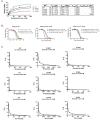This is a preprint.
A yeast-based system to study SARS-CoV-2 Mpro structure and to identify nirmatrelvir resistant mutations
- PMID: 36052369
- PMCID: PMC9435405
- DOI: 10.21203/rs.3.rs-1942964/v1
A yeast-based system to study SARS-CoV-2 Mpro structure and to identify nirmatrelvir resistant mutations
Update in
-
A yeast-based system to study SARS-CoV-2 Mpro structure and to identify nirmatrelvir resistant mutations.PLoS Pathog. 2023 Aug 31;19(8):e1011592. doi: 10.1371/journal.ppat.1011592. eCollection 2023 Aug. PLoS Pathog. 2023. PMID: 37651467 Free PMC article.
Abstract
The SARS-CoV-2 main protease (Mpro) is a major therapeutic target. The Mpro inhibitor, nirmatrelvir, is the antiviral component of Paxlovid, an orally available treatment for COVID-19. As Mpro inhibitor use increases, drug resistant mutations will likely emerge. We have established a non-pathogenic system, in which yeast growth serves as a proxy for Mpro activity, enabling rapid identification of mutants with altered enzymatic activity and drug sensitivity. The E166 residue is known to be a potential hot spot for drug resistance and yeast assays showed that an E166R substitution conferred strong nirmatrelvir resistance while an E166N mutation compromised activity. On the other hand, N142A and P132H mutations caused little to no change in drug response and activity. Standard enzymatic assays confirmed the yeast results. In turn, we solved the structures of Mpro E166R, and Mpro E166N, providing insights into how arginine may drive drug resistance while asparagine leads to reduced activity. The work presented here will help characterize novel resistant variants of Mpro that may arise as Mpro antivirals become more widely used.
Conflict of interest statement
Competing Interests
The authors declare no competing interests.
Figures




References
Publication types
Grants and funding
LinkOut - more resources
Full Text Sources
Research Materials
Miscellaneous

